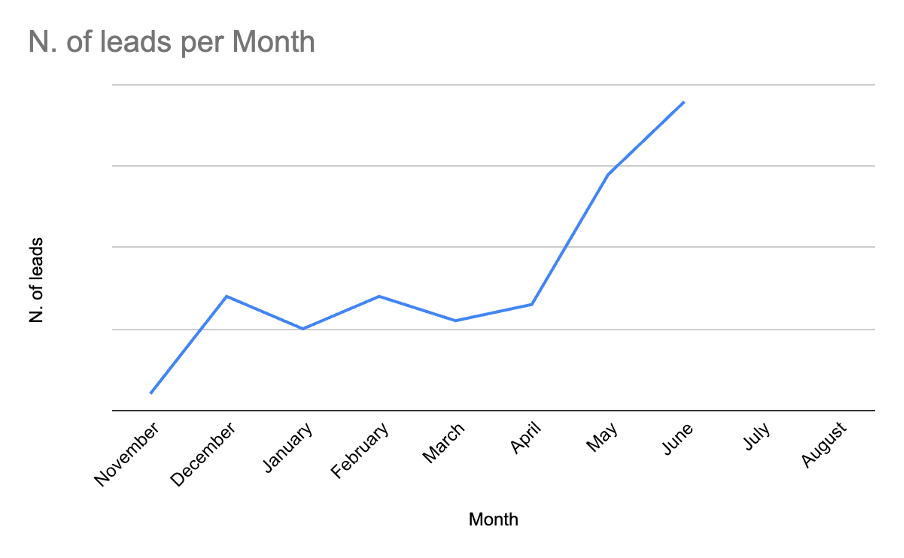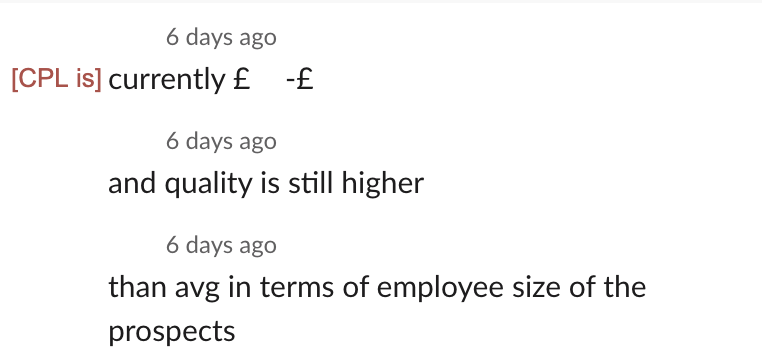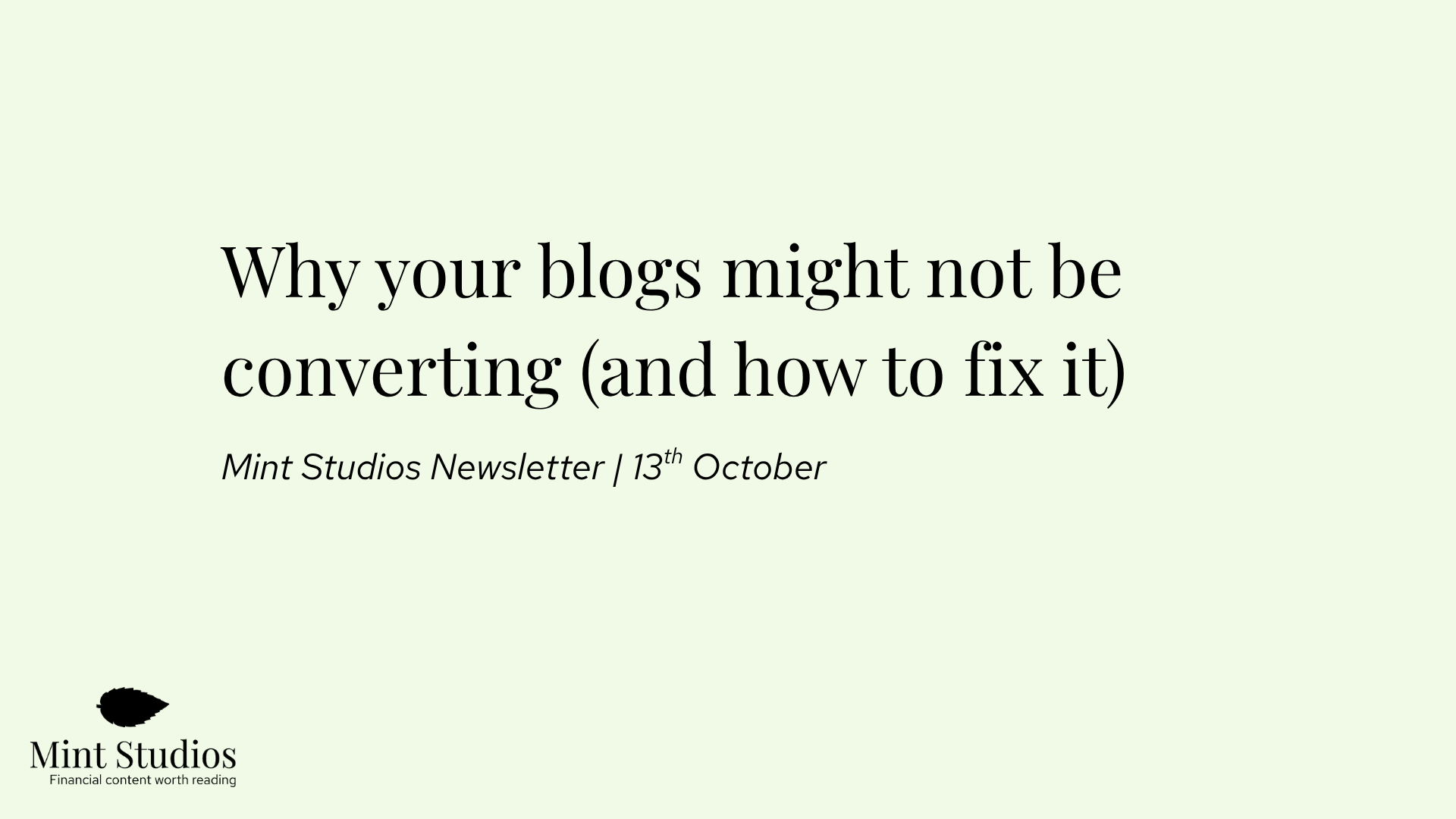One of the first questions fintech marketers and CEOs ask us when we start talking about content for lead generation is: how many leads can we get with your type of content?
The answer, of course, is it depends.
However, there are ways we can get closer to the answer by explaining what it depends on and what we’ve seen works over time. We’ll also be using real examples with real data from clients of ours to explain the answer to that question.
Please note that there are exceptions and these are not strict guidelines, this is just what we’ve found works for us.
Here’s what we’re covering in today’s article:
- What type of content marketing are we talking about?
- So, what does it depend on?
- How many leads can you generate with content marketing?
- The other benefits of content marketing
Note: want to get these article in your inbox? Join our newsletter, every 2 weeks we send out our recent articles!
What type of content marketing are we talking about?
If you’ve followed us for a while, then you’ll know that our type of content marketing means blog content that is published on the website.
Specifically, our type of content marketing focuses on creating content that targets prospects who are at the end of the buying journey: in other words, they are close to converting. You can read the following articles to understand more how we think about this type of content:
- What is BOFU (Bottom of the Funnel) Content and Why Is it Important?
- Content Attribution: How to Calculate How Many Customers You're Getting with Content
With our four pillar framework, we help fintech companies create expert-based content that brings in leads and customers, often worth thousands of dollars.
🏛 A content strategy focused on Bottom of the Funnel
🏛 Content for the level of your reader and focused on your product
🏛 Content based on interviews with experts
🏛 Content with a measurable ROI
Read more about our methodology: Mint Studios framework
The reason we mention this is to make it clear that we’re not talking about video content, gated content or social media. For the sake of this article, we’re talking about blog content.
So, what does it depend on?
As we mentioned above, the answer to that question depends on a few factors. These are the questions and factors we consider before working with a fintech company.
How strong and established your website is
This is the first thing we look at when a fintech company comes to us: how long your website has been around and what is its authority.
We typically put the URL into SEMRush, and check the domain authority of the website:

If the domain authority is under 20, it could take a little longer than usual to get results (although not always). If you’re starting from scratch with a new website, it could take over a year (although not always).
That’s because Google rewards websites that have backlinks and authority. If your website is younger or has less authority, it simply means it could take longer to get your blog posts ranking on Google, and therefore longer to get people reading your blog posts and converting.
If your website is on the younger side and you are still testing your messaging and acquisition channels, we would recommend working with a freelancer who can work more closely with you and help you test your positioning. You can find a list of ones we recommend here: Top Fintech Marketing Agencies and Fintech Writers.
Whether you’ve acquired customers cold before
The next thing we look at is if you have already acquired customers cold. This is because if you’ve only acquired customers via word of mouth or in-person, then you haven’t proven that your target market doesn’t need a high level of trust in order to convert.
If your competitors have a proven track record of acquiring customers via ads or other cold acquisition methods, for example, then it’s a lot more likely you’ll be able to acquire customers via content.
And if your content or Google Search ads have already brought in customers for you, then this is a great sign that Bottom of the Funnel content will work for you as well.
Whether customers are researching information online
The other thing you want to ask yourself is: is your target market doing research online for your product?
Although it’s not impossible, it can be harder to create content and rank on Google if your target market isn’t aware of your product.
For example, if you’re a fintech company that helps with pensions or savings accounts, you’re a lot more likely to acquire customers with content since people are actively searching online for these products as well as for information.
If you’re a fintech company that offers a new way to pay for stuff (think BNPL before it was well known), it might be a bit more difficult since you are essentially creating a new industry. It’s not impossible, but it might be a little more difficult.
How you measure leads
Revenue attribution is not perfect for content marketing. There are people who will read your blogs, and then convert one year later. There are people who will read your blogs, then recommend you to someone else who will then convert. And there are people who will convert and then read your blogs.
It’s difficult to track accurately. But the great thing about digital marketing is that we can track something, and that’s better than nothing.
When you’re speaking to the board or your leadership team, some numbers that prove the effectiveness of content are better than nothing – especially when you’re speaking to non-marketing people (as is often the case in fintech).
In order to answer the question “how many leads can you generate with content marketing?”, you first need to agree on what a lead is. Is it someone who submits a form? Someone who creates an account? Or someone who clicks on a specific button?
Once you’ve agreed on what a lead is, you want to make sure you can attribute it to content in some way.
For example, form submissions, clicks and “create an account” can be tracked via tools like Google Analytics, Hubspot and Salesforce.
With Hubspot, you can attribute leads, opportunities and even revenue to specific blog articles:

Read about how to use Hubspot to attribute leads to content here: How to Track the Quality of the Leads Your Content Brings in [With 6 Hubspot Reports]
One important thing to note is: when we talk about lead generation, we talk about attracting and targeting people who are very close to buying. Typically we’re talking about leads and qualified leads. We’re not talking about using gated content, newsletters or other types of lead generation.
How many leads can you generate with content marketing?
Now that you understand what it depends on and what we’re measuring, we can attempt to answer this question with data-backed examples and case studies.
Parpera: B2C with a price point of $120 AUD per year
Parpera is a neobank for freelancers based in Australia. Although freelancers are a business, there is only one decision maker so we’re classifying this as B2C.
When we started working with Parpera, they had a lower DA (under 25) and the product had just been launched. There was little competition, since there wasn’t a product quite like Parpera in Australia. We knew this was a product that would do well since it succeeded in other countries, and there were some indirect competitors doing quite well.
The first piece we did directly described the product: “sole trader bank account”. It was a competitive term, but we knew that anyone searching for this was ready to buy and very much in our target market, so it was a no-brainer.
We then did a few comparison pieces. In the world of freelancing, freelancers are often juggling multiple tools: one tool for accounting, one for invoicing, one for managing clients, and a lot more. What made Parpera unique was that it did all these things in one platform. So we wrote a few pieces that would compare Parpera to these tools and allow us to make a case as to why Parpera was a superior product for certain freelancers.
We were starting off with a small amount of traffic, but once we started publishing in November and December, traffic started to grow. We were also happy to see a few leads come in December.
You can see here how organic traffic grew over time.

Here’s the leads month over month:

From December to April, there was fluctuation of leads, but there was a steady growth of both traffic and leads. Things really took off in April/May, which was month 5 of publishing content. By then, leads increased by 50%, and then 20% for the next two months.
(in June the Parpera app had to be taken down due to an issue with their banking partner, so we’re not able to track the number of leads after June)
As you can see, we were able to bring in leads from month 2, and we were able to generate some conversions even when organic traffic was low. Things really took off in month 5, when we were ranking higher up on Google and traffic started to increase.
The great thing about our content strategy is that we ended up bringing enough leads that content was more cost-effective for Parpera than leads coming via ads. You can learn more about our exact approach with Parpera including how we wrote about the product and our thinking here: How Parpera Used Content to Help Advance Their Mission of Financial Education and Acquire Customer Leads More Cost Effectively than with Ads
How many leads did we generate with Parpera? With a strong product, low domain authority and low competition, we were able to bring in a small amount of traffic and leads within month 2. Leads and traffic really took off in month 5, with a steady growth of 20%.
VC backed B2B company with a payment product targeting startups and scale-ups
When we started working with this company, the website had a strong domain authority of over 25. However, they were in an incredibly competitive space and with a mature product.
A mature product meant competition would be higher, but it also meant we knew content would be a good customer acquisition channel since others had done it before (and they weren’t doing a lot of Bottom of the Funnel content).
When we started to work on the content strategy, we knew that we would need to make the differentiation of our client’s product clear, and to really speak to our target’s audience pain points.
The first piece we did focused on the story of the company, to help make a case for the product and explain to readers why this product was different and when it was better. The next few pieces we did were comparison pieces, because we knew this was a product that people would compare regularly with others.
Thanks to the strong authority of the website, we were able to get some leads and traffic, once again within month 2.
In this case, things started to take off at month 3, and lead growth has been hovering at an average of 5% every month (although there are fluctuations). The traffic and leads have been stable over time since then.
You can see the graph here for traffic. Please note this is traffic to the blog posts we’ve written only, not to all the posts on their blog.

We were able to hit 30 leads per month with this company, and although there are fluctuations (as you can see in this graph), there has been steady growth.

(as you’ll notice, leads were down a few months in between. This is because we were publishing more middle to top of the funnel content for a separate objective of this company (this also demonstrates what happens if you don’t publish BOFU content regularly))
With this company, we didn’t see a big spike in traffic like we saw with Parpera because the website already had strong authority and we weren’t starting from scratch. Once again, this demonstrates how traffic is not always directly linked to leads. The month with the highest number of leads wasn’t the month with the highest number of pageviews, and vice versa.
This further proves that an increase in traffic does not mean an increase in leads
How many leads did we generate with this company? This company had a strong website, mature product and high competition, we were able to get around 10 leads per month within month 2 and 3 and our highest point so far has been 30 leads per month.
Scale-up B2B company targeting enterprise and multiple verticals, with a price point of £100k+ per year
With this fintech company, we were starting off with a reasonably good DA.
They were in quite a competitive space, but the opportunity was high because few of their competitors were creating this type of content. The downside was that because it was so niche and specific, we’d have to target technical people and rank for very specific keyphrases (like “account aggregation api”), with much lower search volume. Luckily, we care about leads and customers, and not traffic.
When we started creating content, we decided to start off with a “best of” post along with a super focused technical post. Both had under 30 searches per month, but because they were so high intent and low competition we thought it would be worth it.
Read more about: Low Volume, High ROI Keywords: Why You Should Include Them in Your Content Strategy
And we were right! Within month 2, we were able to bring in some incredibly high quality leads, some which have already turned into customers worth in the thousands of dollars. We were able to track this thanks to their integration with Salesforce and Hubspot.
Let’s first look at the traffic. As you can see from this graph, traffic took a while to grow but we eventually hit 1,500 pageviews per month in March, 10 months after we started (once again, we’re only tracking traffic to the blogs we wrote, not all the posts on their blog).

Even with traffic at a low 200 per month when we firststarted, we were still able to bring in customers worth thousands of dollars. We were able to track the success of our work by setting up a specific campaign that tracked the performance of the blogs that we wrote:

This is, once again, a great example of why traffic is not always the right metric to track. If you care about leads and customers, then make sure you’re tracking that as well. With just a few targeted blog posts bringing in a few hundred pageviews per month, you could be getting high quality leads and customers.

With high ticket B2B, by targeting the right keyphrases and creating in-depth, expert based content we were creating blog posts with a conversion rate of up to 5%. Although we were able to bring in some good results from month 2, it wasn’t until month 9 that things really took off. Because the value of one customer is so high, it was still very much worth it for this client to wait for things to pick up.
How many leads did we generate with this company? This company had a reasonably strong website with customers worth hundreds of thousands, and we were able to bring in leads within month 2. After 11 months working together, we were bringing consistently over 10 qualified leads per month from the blog, all opportunities with deals valued at six figures.
These case studies hopefully demonstrate what to expect in terms of number of leads, what your lead growth might be and how long it can take for content marketing to start working. We usually tell people that you’ll get good results at around month 5, but sometimes this can happen sooner or it can also happen later.
Even though the traffic is low for some of our blogs, the conversion rates often go as high as 5% – and ultimately that’s what matters the most to a business.
As you can see from these case studies, it’s hard to give a specific answer to the question “how many leads can you generate”. But hopefully you can compare and contrast your company with the case studies above, and that should give you an idea of what to expect.
These case studies also demonstrate how important a strong content strategy is. It’s not good enough to come up with random ideas and write what feels good in the moment. You need to think about what the market is like (are people comparing you to competitors), what the opportunity is and what are the most compelling pain points.
When we work with a fintech company, we don’t just look at what your competitors are ranking for and then try to do the same. We think deeply about customer pain points and try and focus on keyphrases that we think will bring in customers. That’s why when we begin working with a company, we spend the first month doing an in-depth discovery to make sure we understand your customers’ pain points, your product and the market.
The other benefits of content marketing
There are many other benefits to content marketing, and it’s not just leads. Some of these are harder to quantify, but worth noting nonetheless.
Increase your lead to customer conversion rate
With content, we’re able to target a very specific type of customer: one that is aware of their problem and is actively looking for a solution.
In fact, there is no other marketing channel that is as targeted as content marketing. Yes, with ads you can target demographics and interests. But with content via Google (and this would include Google Ads), you can target people who are at a specific moment in their journey: they’re ready to buy and are searching for solutions. There is no other channel that can do that at the scale that Google can.
The high level of targeting means that you’re able to target much higher quality customers.
Let’s use a mini case study to demonstrate this:
One of our clients was a VC backed, B2C and B2B product. They were already bringing in a large number of leads with their content, but they were having issues with the quality of those leads.
One of the first pieces we did was a “best of [X]” article, comparing them to competitors and explaining when and for whom their product made more sense.
Because the article was so targeted and no other competitor had written this type of article, it instantly ranked #1 on Google.
This article brought in the same number of leads as some of the other articles, but the size of the company that was applying to their product was double. In essence, we were able to help them acquire a much higher quality customer.
Here’s a screenshot of their Slack message:

This kind of information cannot be tracked via Google Analytics, so we were dependent on their internal growth person letting us know.
But with Hubspot, we can track the quality of a lead, and we actively work with clients to improve the quality of the lead they bring in. With content marketing, you can attract a specific type of customer, ideally one that is better quality.
Read more how to do that here: How to Track the Quality of the Leads Your Content Brings in [With 6 Hubspot Reports]
Help advance your mission of financial education and build customer trust
We’ve written about this before on why fintech needs content and marketing. In high school, we don’t learn about taxes and pensions, so when it’s our turn to care about it, where do we go? Google. When it comes to topics related to finance, most people aren’t educated on the topic.
A lot of fintech companies want to create content because they want to be information focused. One of their pillars is financial education, and content is a channel to do that.
If you take the time to educate your customers, they are a lot more likely to reach out to you and think of you when they have an issue. This is the wider content philosophy: of choosing to be a teacher and educating customers on a multitude of topics.
Content marketing helps advance your mission of financial education.
Position yourself as an expert
Companies come to us saying “we’ve been around longer than our competitors, but no one knows about us”. Public relations is probably the first thing to help with that, but so will content marketing.
When you’re ranking on Google for all the right terms, you’ll keep appearing on your customer’s radar. And when you write content based on expertise, people will see you as an expert. This will help with positioning yourself as an expert, and people will start requesting you on podcasts, asking for quotes, etc.
Having an opinion and a stance on a topic (which is explained via content) means that it’s easier to position you in the market. That helps you establish yourself in the market, which indirectly leads to higher growth.
We hope this article has helped clarify the topic of how many leads you can get with content. Often, we don’t know the real answer until we’ve talked with key stakeholders in the company, taken a look at your analytics and your competitors.
That’s why we don’t work with clients outright: we typically first do a 2 week diagnostic where we spend time trying to understand what’s working well for you currently, what the possible opportunity is and then what that execution looks like in practice. That way we can more accurately tell you: here’s how many leads we could potentially generate with content marketing — and what that may be worth to you.











